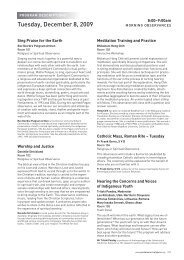Whispers and Vanities in Samoan Indigenous Religious Culture
Whispers and Vanities in Samoan Indigenous Religious Culture
Whispers and Vanities in Samoan Indigenous Religious Culture
Create successful ePaper yourself
Turn your PDF publications into a flip-book with our unique Google optimized e-Paper software.
Let us celebrate this first<br />
The purpose of the t<strong>in</strong>i is to bolster the pr<strong>in</strong>cipals <strong>in</strong> the marriage, namely the bride<br />
<strong>and</strong> groom. It is meant to help them relax, to arouse them <strong>and</strong> set the mood for their<br />
marriage ceremony. The event is meant to be a celebration of the com<strong>in</strong>g together of<br />
two persons <strong>and</strong> two families. It is not meant to be overly formal <strong>and</strong> sombre.<br />
The po<strong>in</strong>t about the biases of Christian Samoa is well noted when exam<strong>in</strong><strong>in</strong>g the<br />
omission of the phrase “mimisā pua’i” (“sacred sperm spew out”) <strong>and</strong> the retention of<br />
“faatu lou i’u” (“get your prick up”, i’u literally mean<strong>in</strong>g an end). The <strong>Samoan</strong> words<br />
<strong>in</strong> the latter are considered less offensive because they are less explicit.<br />
Similarly, two sexually explicit l<strong>in</strong>es of a chant that usually beg<strong>in</strong>s the Salelesi auala<br />
or funeral ritual fall victim to the same dilemma. In this chant if the deceased is male<br />
then the chant is worded:<br />
Talofa i lena ate tele,<br />
o le a pala i le ‘ele’ele<br />
Pity that that great penis,<br />
will now rot <strong>in</strong> the ground. 32<br />
However, if the deceased is female then the chant goes:<br />
Ma’imau lena pali tele,<br />
ua palavale i le ‘ele’ele<br />
That great vag<strong>in</strong>a will be wasted<br />
rott<strong>in</strong>g uselessly <strong>in</strong> the ground. 33<br />
These two l<strong>in</strong>es of chant are the only references to death <strong>in</strong> the vaa funeral ritual.<br />
Instead the vaa ritual gives the sex act pride of place mak<strong>in</strong>g the po<strong>in</strong>t that human life<br />
cont<strong>in</strong>ues despite death. To make this po<strong>in</strong>t the performers move solemnly <strong>in</strong>to a boat<br />
formation, made known by their exaggerated paddl<strong>in</strong>g movements <strong>and</strong> as they move<br />
they chant:<br />
Ina soso atu ia<br />
i lalo o le ‘aute o loo i ai le toea<strong>in</strong>a ma le loomatua<br />
I urge you to approach<br />
Under the hibiscus tree where there is the old man <strong>and</strong> old woman 34<br />
32<br />
The ate is known to literally refer to the liver (see Moyle, 1975: p.232), however <strong>in</strong> common<br />
parlance it also refers to the penis. In terms of the object of this funeral ritual it is more likely that the<br />
po<strong>in</strong>t about the ate is <strong>in</strong> relation to the wasted opportunity to procreate which is better symbolised by<br />
the penis rather than the liver.<br />
33<br />
I share the same <strong>in</strong>terpretation of the term pali as Richard Moyle (1975, p.232).<br />
34<br />
Use of the terms toea<strong>in</strong>a (old man) <strong>and</strong> loomatua (old woman) are deliberate <strong>in</strong> that they<br />
suggest reference to the procreators or parents of, or an older generation to, the performers.<br />
16











